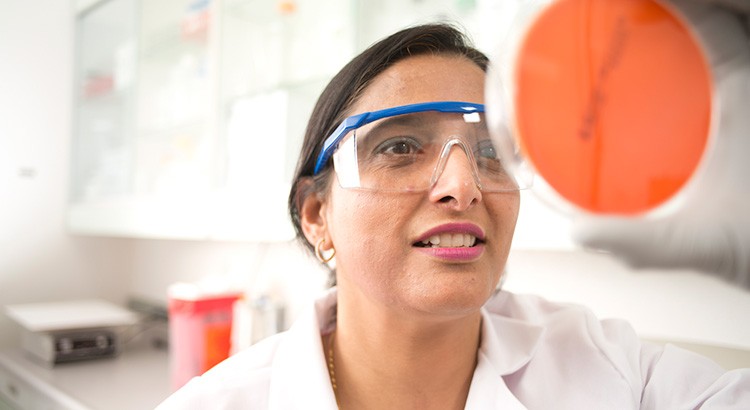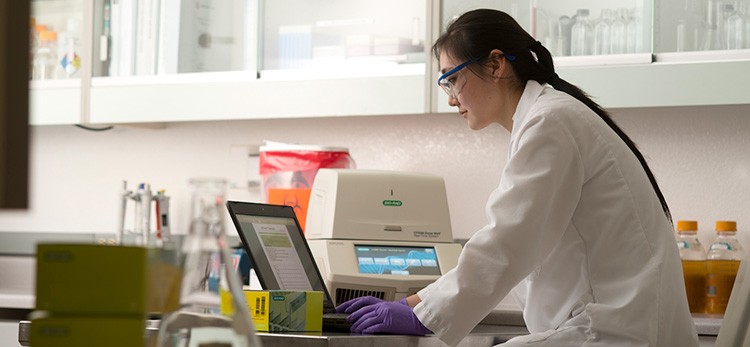Bio-Rad Has a Food Science Division
Most people think of Bio-Rad as a company with two foci: diagnostics and life science research. However, in 1999 Bio-Rad purchased Pasteur Sanofi Diagnostique, a diagnostics company associated with the Institut Pasteur in Marnes-la-Coquette, France.
The food science products made by Sanofi Diagnostics Pasteur were not necessarily the driving force behind the acquisition. Instead, the main business reason Bio-Rad bought the company was its portfolio of medical diagnostics. At first, the food science part of the company — a series of tests centered around food and veterinary pathogen surveillance — ended up part of the larger, innocuously named Industrial Technology Business Unit.
However, that all changed when…
Bio-Rad’s FSD became a key player responding to Mad Cow disease

A Food Science Division client checks for bacterial colony growth on a plate containing Bio-Rad’s RAPID’L.mono™ chromogenic growth medium. FSD products often involve sophisticated microbiology techniques and are known for their reliability and ease-of-use.
Over the 1990s, a crisis unfolded in the UK and Europe involving tainted beef and a new form of illness. Dubbed Mad Cow disease for the afflicted animals’ erratic behavior, Bovine spongiform encephalopathy (BSE) was a neurodegenerative disease that left cows’ brains looking like sponges, shot through with hundreds of lesions. In 1996 the British Health Ministry linked consumption of BSE-affected beef to cases of variant Creutzfeldt-Jakob disease (vCJD), a fatal and incurable human neurodegenerative disorder. Fear gripped the public, and the government destroyed 4.5 million cattle, devastating the agricultural economy.
As a public health threat, BSE and vCJD are insidious foes because they are prion diseases, carried not by a virus or bacteria but by a protein. Prions are misfolded, nonfunctional proteins that “infect” correctly folded central nervous system proteins, binding to them and changing their structure to a nonfunctional form. Over time, this results in amyloid plaque buildup, with associated neurological symptoms and eventually death.
Though rare — to date, only about 250 cases have been identified in humans — vCJD is horrific and difficult to stop for two reasons: The first is that prions are stable at high temperatures, so cannot be destroyed by cooking, and the second is that prion disease can take years or decades to manifest, which makes outbreak tracking especially tough.
Among the diagnostics in development in Bio-Rad’s new food science business was an ELISA test for BSE. At the same time as the acquisition, in 1999, BSE cases began to show up in cattle across Europe. The European Commission announced mass screening of all cows older than 12 months, beginning January 2, 2000. From having only a limited presence in the food science and animal health fields, Bio-Rad had just jumped into the deep end of responding to a major public health emergency in the food supply.
Danny Debecker, a business development manager at the time, remembers the intensity of late 1999. When the mass screening program was announced, Bio-Rad was in a strong position, able to produce and distribute the validated test throughout Europe. However, with orders jumping from the thousands to the millions of tests overnight, actually doing this was no mean feat.
“[The mass screening order] was a shocker because it was such short notice,” says Debecker. “It was a hell of a job because we had only two to three weeks’ time to install a lot of laboratories, so we worked day and night including Christmastime and New Year’s.” Because of concerns about lab technicians working with prions, all labs had to operate at Biosafety Level 2 or higher, making these short-notice installations and trainings even more complex. Still, Debecker and his colleagues’ efforts paid off. Thanks in part to their work in labs across Europe, governmental authorities were able to help ensure the safety of their countries’ food supplies.
Today, FSD’s transmissible spongiform encephalopathy (TSE) tests remain in use in disease surveillance programs around the world. While Mad Cow remains a threat, it has become a manageable one, thanks in part to these screening tools.
The FSD’s headquarters is a scientific landmark and museum
In 1885 Louis Pasteur decamped from central Paris to Marnes-la-Coquette, a suburb near Versailles, to continue his research on a rabies vaccine. Following his success in treating rabies, he went back and forth between Marnes-la-Coquette and the Institut Pasteur in the fifteenth arrondissement of Paris. In 1895, he passed away in his Marnes-la-Coquette apartment, which has been left unchanged since his death.
Today, that site is the headquarters of Bio-Rad FSD R&D, with active research labs and offices adjoining the historical Pasteur apartment and Museum of Research Applications, with the company cafeteria built into the old stables where Pasteur kept research animals.
“As a scientist, I get so excited by that, because it’s history,” says Wendy Lauer, who today is marketing manager for the Food Science Division. “So many of the things we do in microbiology are a result of the things Pasteur did. Our own history in FSD is a continuation of what Pasteur did as well.”
Many challenges faced by FSD are unique, well…because food

A lab technician performs a testing protocol using an iQ-Check® Real-Time PCR Kit. Using PCR to test for pathogenic markers in food involves confronting a unique set of challenges, including complex samples, inhibition of PCR chemistry, and the need to accommodate a wide range of users.
“I don’t know if a lot of people doing research in the lab connect the food they’re eating on their lunch break to the techniques they’re using in the lab,” says Lauer. Behind the production of that sandwich, wrap, or salad, however, are many of the same techniques.
Within the broad field of food science, Bio-Rad’s Food Science Division focuses on pathogen detection and safety testing in food, water, wine, and agricultural settings. The solutions FSD provides to meet these goals involve techniques such as microbiological culture methods, ELISA, and PCR.
However, working with food and the food distribution system poses unique challenges even when using such bread-and-butter life science techniques. Among them:
Some foods inhibit PCR chemistry — PCR is often used as a screening tool; when certain markers show up, more testing for harmful pathogens is warranted. Some foods, such as chocolate and cocoa products, have polyphenols that inhibit chemistry. Spices such as cinnamon also have chemicals that inhibit PCR. At the same time, harmful pathogens such as Salmonella can be present in these foods in very small quantities. Detecting pathogenic markers with PCR requires special consideration of inhibition, and special measures to correct against inhibitory effects.
Complex samples, hidden bacteria — “In a research lab, purifying your sample before running a procedure is common,” says Lauer. “But now, imagine that sample is ground beef.” Not only is the sample very complex, but a pathogen like a harmful E. coli strain can exist at an extremely low level within that complex sample and still be dangerous. FSD scientists must solve problems like understanding the exact growth kinetics of a given pathogen in certain conditions, in order to provide an assay that accurately detects this target in the fastest time.
Complex targets — There are more than 2,500 serotypes of Salmonella. Which sections of their genomes are conserved and could serve as an effective PCR target? Or, alternatively, how do you detect harmful strains of E. coli while not detecting a benign strain? These are also some of the special questions that arise in detecting foodborne pathogens.
Real-time PCR in Bio-Rad FSD ≠ Research lab real-time PCR
Jean-Francois Mouscadet is the Director of R&D for the Food Science Division. “I was in a French academic lab before joining Bio-Rad,” he says. “And I was very surprised by some of the techniques I found in coming to FSD.” In particular, Mouscadet was surprised by the differences in PCR reagents and practices. “People in routine testing labs sometimes think PCR is a very complicated story,” he says. “So we really have to come up with simple ways to do it that are also validated to work 100 percent of the time.” Here are a few:
Taq polymerases that are stable at room temperature — “In academic research labs, researchers are used to PCR enzymes being very fragile,” says Mouscadet. “We keep them at –20 degrees, we work with them on ice. For us in food science, there are so many different kinds of testing situations, there might not always be ice or freezers. So we designed an extremely stable PCR mix with the Taq in it that you can keep at room temperature for two years on your bench. When I first came here, I didn’t believe it. We sent some mix to some Bio-Rad colleagues. They thought we’d send it by dry ice, but we just sent it by regular airmail. They couldn’t believe it either, so they did the controls, and it worked. We’ve even tested it at 37 degrees and it still works after three months.”
Universal lysis buffer — “We’re designing PCR assays to detect pathogens in food and environmental samples,” says Mouscadet. “Those samples can be meat, milk, produce…and the pathogens are in there. Usually you’d have to perform a complete extraction and clean the DNA. But we’ve designed a one-step protocol with a universal lysis buffer. It’s universal for all kinds of samples, for any bacteria. You just take your sample, you add your lysis buffer, then you take an aliquot and do PCR, and that’s it. It doesn’t work well with a very fancy Taq like you might have in a research lab, but with our mix and our Taq, it works perfectly.”
Collaborating with customers, not selling to them

Filtering water to test for pathogenic organisms. FSD sales representatives such as Danny Debecker often have longstanding relationships with their customers, serving as collaborators in all aspects of implementing a successful testing program.
As FSD’s Northern and Central European Sales Manager, Danny Debecker has some customers he’s known for years. “We have a customer in Sweden; if they know that we are coming, they bake us a cake,” he says. “In Finland, you’re invited to the sauna. In Norway, they’ll have a barbecue for you…if there’s sun.”
These relationships aren’t coincidental. Just as Debecker described not just selling testing kits during the Mad Cow crisis but setting up the testing labs, FSD usually acts as a food or testing company’s scientific collaborator, not merely its supplier. That means providing a complete solution and ensuring that a customer has an effective testing program in place.
“We have customers that have gone through outbreaks with previous methods,” says Lauer. “We not only set them up with our methods, we support them with everything — setting up their lab, making sure their second shift is trained, etc…Our responsibility as their partner is to make sure they have their new testing routine working and they are able to bounce back.”
The sheer scale of many food producers today — as well as their need to ensure safety and quality — means that the collaboration has high stakes. Time is an especially precious commodity for global food companies, which often have ships sitting offshore or trucks parked at national borders, waiting for safety certification to get those goods to market. Debecker cited one case in which, by adopting a faster method, a client improving testing speed by one day would save approximately €500,000 (or about $600,000) per year.
Along with such tangible measurements, FSD’s collaborations with its customers bring less tangible — though arguably more valuable — rewards. “Working with our customers to make sure they have the best food safety program they can is very satisfying,” says Lauer. “I know that because of what I do here, somebody’s food will be safer.”

